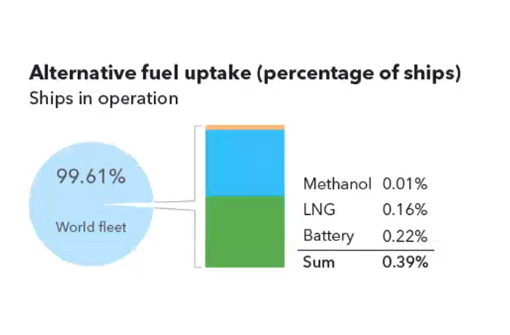

DNV GL pointed to a relatively limited uptake of hydrogen as a ship fuel in the fourth edition of its Maritime Forecast to 2050 presented on Tuesday.
The surprising assessment is a result of both the estimated price of the fuel and the investment costs for the engine and fuel systems.
The forecast aims to set shipping on a pathway to decarbonization by navigating through technological, regulatory, and market uncertainties in the industry.
“The pressure to act decisively is mounting. Perfect is the enemy of good, and so we mustn’t wait for an ideal solution to arrive and risk making no progress at all,” said Knut Ørbeck-Nilssen, CEO of DNV GL – Maritime.
” Using a wide range of scenarios involving different fuel types and technologies, and varying degrees of regulatory pressure, our new report helps to map a way forward, offering shipowners clear insights on how to meet the challenges and opportunities ahead.”
The latest edition features 30 scenarios that project future fleet composition, energy use, fuel mix, and CO2 emissions to 2050.
A total of sixteen different fuel types and 10 fuel technology systems are modeled in the report, outlining the potential risks of each particular fuel choice.
DNV GL believes the increasingly diverse fuel environment means that engine and fuel choice now represent potential risks that could lead to a stranded asset. Factoring in the impacts of availability, prices and policy, on different fuels, makes the choice even more complex.
“By stress testing technology decisions under the various pathways and scenarios, the forecast presents potential performance and the carbon robustness of the various design choices,” the classification society said.
The report dives into three different decarbonization pathways:
- No further decarbonization
- IMO ambitions-at least 50% GHG emissions reduction by 2050
- Decarbonizing shipping by 2040
In the scenarios with no decarbonization ambitions, very low sulphur fuel oil, marine gas oil and LNG dominate. While under the decarbonization pathways, in 2050 a variety of carbon-neutral fuels holds between 60% and 100% market share.
Under the decarbonization scenarios, it is hard to identify clear winners among the many different fuel options, DNV GL said.
Fossil LNG gains a significant share until regulations tighten in 2030 or 2040. Bio-MGO, e-MGO, bio-LNG and e-LNG emerge as drop-in fuels for existing ships.
By 2050, E-ammonia, blue ammonia, and bio-methanol frequently end up with a strong share of the market and are the most promising carbon-neutral fuels in the long run, the report shows.
Hydrogen plays an integral role as a building block in the production of several carbon-neutral fuels such as e-ammonia, blue ammonia and e-methanol, all of which gain significant uptake under the decarbonization pathways.
It may also find niche applications in some vessel types, such as ferries and cruise vessels, as well as in specific regions where investments have been made into local production and distribution.
Less than 1% of world fleet running on alternative fuels
Looking at the current fleet and known orderbook less than 1% of the existing global fleet is running on alternative fuels, while 10% of the current newbuilds are ordered with alternative fuel systems.


The post DNV GL forecasts limited hydrogen uptake as it breaks down fuel choice prospects in shipping’s decarbonization appeared first on Offshore Energy.
